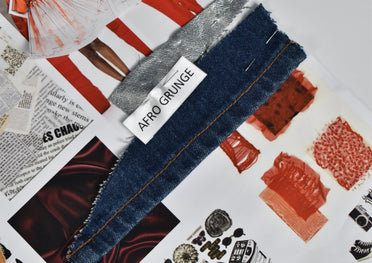How Repair, Mend, and Care Practices Can Redefine Fashion’s Future
[ Story ]
Article

In the battle against fast fashion’s environmental toll, an old yet transformative philosophy is gaining ground: repair, mend, and care. These practices, which focus on extending the life cycle of garments, are a direct challenge to the disposable culture that has dominated the fashion industry for decades. By rekindling a culture of care, individuals, brands, and communities can reshape fashion into a more mindful and enduring space; and it's precisely within this movement that we at Sneaker LAB are forging our vision for fashion’s future.
Fast fashion has long thrived on speed and disposability. By pumping out trendy, low-cost garments at breakneck speed, the industry encourages overconsumption that results in staggering amounts of waste; waste that often finds itself in the Global South, as reported by McAndrew Leadership in their findings, ‘Fashion’s Global Footprint: Fast Fashion’s Toll on the Global South’. Also, according to the Ellen MacArthur Foundation, the equivalent of one garbage truck of textiles is landfilled or burned every second. Textile production accounts for 10% of global carbon emissions—more than international flights and maritime shipping combined.


A growing awareness of fashion’s ecological footprint has spurred interest in extending the life cycle of clothing, and practices by everyday people are proving instrumental in the mindset shift that we so desperately need around our material possessions. Repairing, mending, and proper care practices are no longer being seen as outdated or frugal practices, instead, we have seen firsthand how these can be vital components of a sustainable future. Repairing and mending clothes were once common household skills, passed down through generations and today, the resurgence of these practices reflects a broader cultural shift toward sustainability.
Visible mending, for example, is a technique that transforms repairs into unique design statements. As Vogue writer Sarah Spelling described it, this act ‘is a sartorial equivalent of life support’, in which darned embroidery is used to repair and patch garments, while equally serving as a unique imprint from the mender.
Outdoor retailer Patagonia, perhaps the greatest success story we have in sustainable fashion at scale, has long championed repair as part of its business model — offering repair guides and services to customers. Swedish fashion brand Nudie Jeans and Outerknown have also embraced lifetime repair policies, with Nudie Jean introducing tailoring and mending directly in the stores as a community feature for their customers.
Outdoor retailer Patagonia, perhaps the greatest success story we have in sustainable fashion at scale, has long championed repair as part of its business model — offering repair guides and services to customers. Swedish fashion brand Nudie Jeans and Outerknown have also embraced lifetime repair policies, with Nudie Jean introducing tailoring and mending directly in the stores as a community feature for their customers.





Many of us lack the skills or time to repair their clothes.
It was once an intrinsic part of our lifestyle habits, until the convenience of cheap replacements began to outweigh the effort required for mending. Fast fashion’s emphasis on low-quality materials also makes some garments nearly impossible to repair effectively. To overcome these obstacles, we think education and accessibility are key. Sewing workshops, online tutorials, and community repair events are empowering individuals to take control of their wardrobes. Organisations like Repair Cafés, which provide free spaces for people to fix their belongings, are gaining popularity worldwide. These initiatives are waste reductive and community-building, all the while encouraging a deep sense of self-sufficiency that society appears to outsource in greater ways.
Finding a tailor in your area that can assist in repairing clothes is another way to engage in this process, especially if picking up a needle and thread is not something you’ll ever be into. Family-run tailor shops and artisans are more prevalent than we think and especially in Cape Town, it represents a long tradition that has to be upheld, given the cessation of our once burgeoning textile and garment manufacturing industry.
Beyond repairs, proper garment care plays a critical role in sustainability. Washing clothes less frequently, using the correct products and air-drying instead of tumble-drying can significantly extend a garment’s lifespan while reducing energy consumption. Specialised products, such as eco-friendly detergents and fabric fresheners, are making these practices easier and more effective. This is where our role as Sneaker LAB comes in and our work is a prime example of innovation in this space. By developing biodegradable care products, we assist our community in maintaining their footwear and garments without harming the environment. With the power of intelligent probiotics, our products are designed to encourage a culture of care and maintenance for the things we own and love, beyond just throwing them in the washing machine (or worse, like leaving sneakers to accumulate dust and debris…). We believe that each moment of care extended to what we own, contributes to a shift in personal philosophies for how we choose to engage and show up with fashion and style.
Repairing, mending, and caring for clothes offer tangible benefits beyond sustainability. Economically, extending the life of garments reduces the need for frequent purchases, saving consumers money in the long run. Environmentally, keeping clothing in use for an extra nine months can reduce its carbon footprint by up to 30%, according to WRAP’s Valuing Our Clothes report. These practices also challenge the relentless pace of consumption. By valuing durability over disposability, consumers can shift demand away from fast fashion’s unsustainable model. This ripple effect has the potential to transform supply chains and incentivise brands to prioritise quality and longevity in their designs.
Finding a tailor in your area that can assist in repairing clothes is another way to engage in this process, especially if picking up a needle and thread is not something you’ll ever be into. Family-run tailor shops and artisans are more prevalent than we think and especially in Cape Town, it represents a long tradition that has to be upheld, given the cessation of our once burgeoning textile and garment manufacturing industry.
Beyond repairs, proper garment care plays a critical role in sustainability. Washing clothes less frequently, using the correct products and air-drying instead of tumble-drying can significantly extend a garment’s lifespan while reducing energy consumption. Specialised products, such as eco-friendly detergents and fabric fresheners, are making these practices easier and more effective. This is where our role as Sneaker LAB comes in and our work is a prime example of innovation in this space. By developing biodegradable care products, we assist our community in maintaining their footwear and garments without harming the environment. With the power of intelligent probiotics, our products are designed to encourage a culture of care and maintenance for the things we own and love, beyond just throwing them in the washing machine (or worse, like leaving sneakers to accumulate dust and debris…). We believe that each moment of care extended to what we own, contributes to a shift in personal philosophies for how we choose to engage and show up with fashion and style.
Repairing, mending, and caring for clothes offer tangible benefits beyond sustainability. Economically, extending the life of garments reduces the need for frequent purchases, saving consumers money in the long run. Environmentally, keeping clothing in use for an extra nine months can reduce its carbon footprint by up to 30%, according to WRAP’s Valuing Our Clothes report. These practices also challenge the relentless pace of consumption. By valuing durability over disposability, consumers can shift demand away from fast fashion’s unsustainable model. This ripple effect has the potential to transform supply chains and incentivise brands to prioritise quality and longevity in their designs.

Innovation and tradition are working hand in hand to redefine sustainable fashion.
On the one hand, brands like us are leveraging technology to create products that align care with environmental responsibility. On the other hand, traditional skills such as darning, patching, and natural dyeing are making a comeback, offering age-old solutions to modern problems.
At its core, the movement to repair, mend, and care for clothing represents a cultural shift. It’s a rejection of the throwaway mindset that has dominated consumer behavior and an embrace of mindful consumption. This shift is underpinned by how we can reimagine value, creativity, and responsibility in the context of fashion. As this movement grows, it’s reshaping our relationship with clothing. Instead of viewing garments as disposable commodities, we’re learning to see them as investments—in our wardrobes, the environment, and future generations. By choosing repair over replacement, care over neglect, and quality over quantity, we can collectively transform fashion into a force for good.
Repairing, mending, and care practices are actionable strategies with the power to revolutionise the fashion industry. We will continue to innovate alongside other brands and individuals who embrace these practices, as the potential for change is immense. We hope you will join us in seeding this culture of care.
At its core, the movement to repair, mend, and care for clothing represents a cultural shift. It’s a rejection of the throwaway mindset that has dominated consumer behavior and an embrace of mindful consumption. This shift is underpinned by how we can reimagine value, creativity, and responsibility in the context of fashion. As this movement grows, it’s reshaping our relationship with clothing. Instead of viewing garments as disposable commodities, we’re learning to see them as investments—in our wardrobes, the environment, and future generations. By choosing repair over replacement, care over neglect, and quality over quantity, we can collectively transform fashion into a force for good.
Repairing, mending, and care practices are actionable strategies with the power to revolutionise the fashion industry. We will continue to innovate alongside other brands and individuals who embrace these practices, as the potential for change is immense. We hope you will join us in seeding this culture of care.


[ Follow ]



